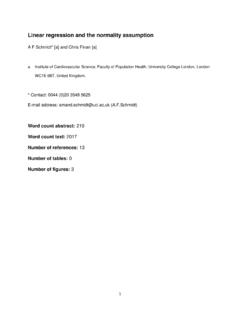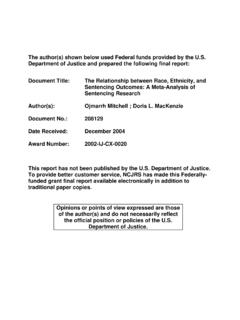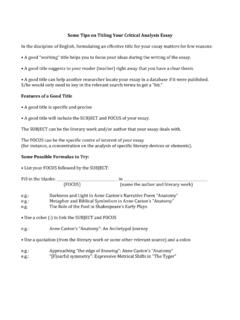Transcription of A Hybrid Approach to Thematic Analysis in Qualitative ...
1 A Hybrid Approach to Thematic Analysis in Qualitative Research: Using a Practical Example Jon Swain University College London, UK Discipline Sociology [D1] Sub-discipline Sociology of Education [SD-Soc-12] Academic Level Postgraduate Contributor Biography Jon Swain currently works at University College London where he is a senior researcher and lecturer. He mainly carries out Qualitative research, which has included a series of numeracy and literacy projects in the post-16 sector. He has also written many articles on boys masculinities. Between 2008 and 2013, he was program leader for the MPhil/PhD; he also has extensive teaching experience on the EdD program and continues to supervise and tutor both PhD and EdD students. His professional career began as a primary school teacher, and he took a part-time MA at the Institute of Education in the late 1990s before completing his PhD in 2001.
2 Abstract Building on previous literature in the field of Qualitative Analysis , this case presents a flexible framework for using a form of Thematic Analysis employing a Hybrid Approach of deductive and inductive reasoning. The Analysis is based on 25 semi-structured interviews from a real-life, Qualitative , study about people s attitudes toward retirement and their expectations of growing older. This case also provides details of actual codings, examples of interview data, which are organized in a Microsoft Word document, and a table (or spreadsheet) that is an integral constituent of the Analysis . The process is organized in three phases, containing seven stages in total, many of which can be concurrent and followed in any order. The Analysis is viewed as being ongoing, organic, and iterative, requiring the researcher to be reflective and reflexive.
3 Learning Outcomes By the end of this case, students should be able to Understand more about using Thematic Analysis in Qualitative research Apply a specific Hybrid Approach to using Thematic Analysis Appreciate the number of decisions that the researcher needs to make when conducting Qualitative Analysis Case Study Introduction Although researchers in the social sciences often include intricate accounts of the methods they have used and present detailed accounts of the findings from their investigations, the process of Analysis is frequently one of the least discussed parts of the research procedure. Centered on a recently completed study, this case sets out a framework for using a form of one of the most widely used methods of Analysis Thematic Analysis which, in this case, uses a particular Hybrid Approach involving deductive and inductive reasoning.
4 There has been a good deal of literature on the subject of Thematic Analysis over the past two decades ( see Boyatzis, 1998; Braun & Clarke, 2006, 2013; Clarke & Braun, 2013; Fereday & Muir-Cochrane, 2006; Guest et al., 2012; Joffe, 2011), and the focus of Jennifer Fereday and Eimear Muir-Cochrane s article is specifically on using a Hybrid methodology. Much of the writing is practical, providing step-by-step guides to assist masters and doctoral students, and indeed professional researchers, in their own Analysis of Qualitative data, although some people choose to use the guides more loosely, and less prescriptively, than others. The aim of this case is to provide guidance on how to use a particular form of Thematic Analysis , and although it builds on the influential work cited in the previous paragraph, there are a number of significant differences.
5 For instance, rather than set out a detailed linear procedure, I present an overarching flexible framework, and although I delineate a number of specific stages, many of these can happen concurrently, rather than sequentially. The process of Analysis is viewed as ongoing, organic, and iterative, and the researcher needs to be reflective and reflexive. I base the Analysis on a real-life project about people s attitudes to retirement and their expectations of growing older, which used interviews as its main research method. Unlike many of the other guides, I also provide details of actual codings that I used, examples of interview data, which are organized in a Microsoft Word document, and present a table or spreadsheet that is an integral constituent of the Analysis .
6 I begin with a definition of Thematic Analysis , followed by a brief introduction to the research study, which I am using as a vehicle on which to base the method of Analysis . The main part of this case outlines the process of Analysis I used, which can be employed as a tool by teachers, students, and researchers. The case concludes with an evaluation of the method and considers how it can also be used with CAQDAS (computer-assisted Qualitative data Analysis ). Thematic Analysis Qualitative methods of Analysis can be notoriously varied and complex (Holloway & Todres, 2003), and Harry Wolcott (1994) points out that there are at least 50 distinct types of Analysis to choose from, including content Analysis , interpretative phenomenological Analysis , template Analysis , discourse Analysis , narrative Analysis , and conversation Analysis .
7 It can appear a daunting task to try to make sense of what can seem like an overwhelming amount of data and transform into a readable form (Wolcott, 1994). Although there are a number of textbooks about Qualitative Analysis ( , Given, 2008; Grbich, 2006; Ritchie et al., 2013), which provide a number of articulations of the process, the basic principle of Qualitative Analysis is summarized by Matthew Miles and Michael Huberman, who describe the three concurrent flows of activity, which all analyses need to follow (Miles & Huberman, 1994, p. 12): that is, data reduction, data display, and conclusion drawing. Thematic Analysis is the most widely used Qualitative analytic method in the social sciences across a range of disciplines, such as sociology, anthropology, and psychology.
8 Virginia Braun and Victoria Clarke (2006) maintain that Thematic Analysis is the first Qualitative method of Analysis that researchers should learn as it provides a set of foundational, core techniques and skills that are used in many other forms of Qualitative Analysis , some of which have already been mentioned. Braun and Clarke also argue that Thematic Analysis provides a great deal of flexibility and can be applied across different epistemological and ontological positions. Fereday and Muir-Cochrane (2006) describe Thematic Analysis as being a search for themes that emerge as being important to the description of the phenomenon (p. 82). It is a method, or process, for identifying and encoding patterns of meaning in primary Qualitative research (Braun & Clarke, 2006, 2013); it pinpoints and organizes the themes which the analyst deems to be important in the description of the phenomenon under study and are often associated with a specific research question (Daly et al.)
9 , 1997). Details of the Study That I Am Using to Illustrate the Method This particular method of Analysis is based on a project that I have recently completed, which was about people s attitudes toward retirement and their feeling toward old age (hence known as the retirement study ). I use this research purely as an example to demonstrate the process of Analysis that I set out in this case, but it could be one of many, relatively small, Qualitative research studies that I have worked on over the past 15 years. This particular study actually used mixed methods and the Qualitative element (Creswell, 2007), which forms the basis of this case, involved carrying out a series of in-depth individual interviews with 25 people. Although they included a mixture of women and men, living in a variety of family circumstances, all the participants were approaching 60 years old, were White British, and were in either full-time or part-time employment.
10 As a sociologist, I am interested in human relations and practices and how they make meanings. The epistemological Approach to the study was informed by Alfred Schutz s (1970) theory of social phenomenology, which is an interpretive theory of social action that explores the subjective experience within the taken-for-granted, commonsense world of the daily life of individuals (Fereday & Muir-Cochrane, 2006, p. 81). The underlying assumption of the theory is that in the lived reality of daily life people are able to attribute meanings to situations and make a series of judgments. The primary objective of the data collection was to represent the subjective viewpoints of the participants on a range of issues. The interviews were semi-structured (Cohen et al., 2011; Robson, 2011), which is a commonly used method in Qualitative research that not only provides a framework but also gives the interviewer the flexibility to probe on certain issues with more open and follow-up questions.











